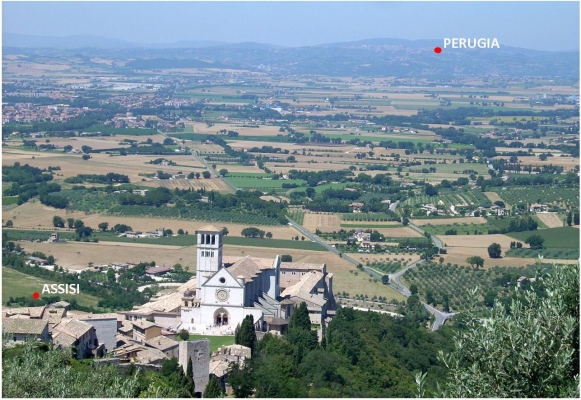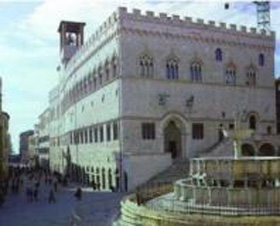Our Location

ABOUT ITALY
Italy has been the “Home”, the European cradle of culture and of civilization.
Italy has been and is a preferred destination of travel writers and poets who have sung in their ways as a place of great charm.
Italy is a crossroads of many cultures and different people.
It’s a cosmopolitan place for ancient vocation, of language, art and culture.
Italy is the Country of imagination and science, the invention and research, it is a place of "lifestyle" for excellence, it is the Country for an amazing holiday, where the climate is mild, and arts and culture are an integral part of life for all. Beauty and taste are a national affair.
Italy's capital, Rome, has been the centre of Western Civilization and is the centre of the Catholic Church.
Seventy percent of the historic heritage and artistic patrimony of the world resides in Italy.
But Italy is also the Country of Calcio, the Country of Soccer, the Country of Football!
WE ARE LOCATED...
ITALIA, Umbria Region - City of PERUGIA and ASSISI
Umbria is a region of central Italy bordered by Tuscany to the west, the Marche to the east and Lazio to the south. Famous and characteristic cities and villages of Umbria are: Perugia, Assisi, Gubbio, Spoleto, Orvieto, Todi, Foligno, Spello, Città di Castello. This region is mostly hilly or mountainous.
OUR CHOICE
We chose to create our Italian Soccer School and to develop all our Soccer Programs in Umbria, specifically in Perugia and Assisi, because the areas are particularly suitable for sporting activities and for a safe and healthy lifestyle.
Our program takes place in a complete training centre in a beautiful green area of Perugia, for both boys/girls who attend the “High School Program” and for those who attend courses at the "University".
The 'High School Programme', is held in Assisi at the famous college "Convitto Nazionale" in which students live and have their own rooms.
The 'University Programme', is held in Perugia at the prestigious “University for Foreigners” and in this case students are provided with rooms and /or apartments in the city centre of Perugia.
UMBRIA REGION
The Umbria region and its territory are called, "il cuor verde d'Italia", "the green heart of Italy" (the phrase, has been taken from a poem by Giosuè Carducci). The economy of the region is based on agriculture that produces olives, grapes, wheat and tobacco.
Industry is based on the steel factories of Terni that harness the hydroelectric power of the Marmore Falls created by the Romans.
Perugia represents of the most important food industries of Italy: “Perugina Chocolate Factory”; the production of Extra Virgin Oil of Olive (from Assisi, Spoleto and Trevi), the production of wine (from Montefalco, Torgiano and Trasimeno Lake) and the truffles of Norcia, all represent an important aspect of the Italian economy. Tourism is an important and fundamental economical factor for the regional economy, especially in the districts of Perugia, Assisi, Gubbio, Spoleto and Orvieto.
CITY OF PERUGIA
 Is the capital of Umbria and dominates the Tiber river valley from a high, irregular and rough hill: the particular feature of the land has generated a wide variety of urban situations, giving the town a very special aspect.
Is the capital of Umbria and dominates the Tiber river valley from a high, irregular and rough hill: the particular feature of the land has generated a wide variety of urban situations, giving the town a very special aspect.
Palazzo dei Priori: center of the Government of the city. The rich artistic and cultural patrimony and the natural environment make Perugia a unique city of major importance from the beginning of its history.
The city symbol is the “griffin” (see the coat above), which can be seen in the form of plaques and statues on buildings around the city. Perugia today is a modern and cosmopolitan city known all over the world because of its cultural events and the University for Foreigners.
Perugia, in fact, hosts two main universities: the ancient “Università degli Studi” (1308) and the “University for Foreigners” (1925) that serves as an Italian language and culture school for students from all over the world and the Umbria Institute, an accredited university programme for American students studying abroad.
Perugia has become famous for the chocolate, mostly because of a single firm, “Perugina”, whose “Baci” (kisses) are widely exported. Eurochocolate festival, which encompasses all of Perugia’s historic centre, is another important and great event.
The “Perugia Eurochocolate” (in October of each year) has earned in a couple of years the sympathy of the people asserting itself as the most popular festival of the chocolate and the most followed by Italians, making of Perugia the European capital of the chocolate.
For nine days the Umbrian chief town transforms itself for the occasion in a huge open-air pastry-shop for the delight of all the chocoholics.
At Eurochocolate Perugia’s Festival, dozens of big events are organized and showcase the "food of the gods" with exhibitions, laboratories, internships, cooking classes, tasting, expositions, banquets, celebrations and the final prizes: Eurochocolate Awards. For all the tourists the occasion is without any doubt a good one to discover the most remote corners of this antique medieval centre and to enjoy the famous Umbrian hospitality. Another very important and famous event in Perugia is the Europe's largest jazz festival in early July for ten days.
From morning to evening, Perugia’s historic centre transforms itself to the grand stage with beautiful concerts echoing throughout the streets.
Once again, a meeting point for thousands of music lovers, coming not only from all over Italy but also from Europe and North America.
The “Umbria Jazz Festival” is without any doubt, one of the most important venues for Jazz & Blues in Europe and has been held annually since 1973. The biggest jazz and blues (and pop in the last years) artists have came to Perugia.
A remarkable number of foreign citizens accounting for around 8% of the city's total population have chosen Perugia as the city to live, study, work and raise their children. In the latest years a substantial increase in the presence of foreigners in Perugia has been recorded.
CITY OF ASSISI
 It would take far too long to illustrate the history, places, and the importance of the town of Assisi, famous all over the world for being the birthplace of St.Francis.
It would take far too long to illustrate the history, places, and the importance of the town of Assisi, famous all over the world for being the birthplace of St.Francis.
In the heart of Umbria, 20 minutes away from Perugia, half way up the slopes of Mount Subasio at 424 metres above sea level, lies Assisi, a town extraordinarily rich in tourism, art and cultural attractions. The territory of the Assisi Tourism occupies the northern part of the Umbrian valley, bound to the north east by Mount Subasio and to the South east by the hills that separate it from the Tiber Valley.
Assisi represents an ensemble of masterpieces of human creative genius, such as the Basilica of San Francesco, which have made it a fundamental reference for art history in Europe and all over the world.
Assisi is a must-see destination for international tourism for many reasons: the figures of Saint Francis (1182-1226) and Saint Claire (1193-1253) who continue to fascinate believers - of whatever creed - and non-believers alike for the freshness of their message; the marvelous Basilicas dedicated to them, where in the works of the greatest painter of the era it can be said that genius of Giotto blossomed and modern painting was born; the typical medieval urban structure of the city which in great part follows that of the Roman settlement with important finds such as the colonnade of the Temple of Minerva; the green of the woods of Mount Subasio and of the surrounding countryside which encroach upon its ancient walls; its happy position on a hillside from which a glance embraces the entire Umbrian valley.
Along with this comes a variety and comfort of its hospitality structures which embody true cordiality in welcoming pilgrims, tourists and students.
The most famous building of Assisi is without any doubt the Basilica of St. Francis (photo) and the Sacro Convento (monastery), but the tourist must pay visit also to the Churches of St. Clare(the body of St. Claire is preserved in the crypt) and St. Peter.
Finally, in the plain (suburb of Assisi is about 5 km), the impressive Basilica di Santa Maria degli Angeli was built according to the plans of Alessi between 1569 and 1679 to protect the Purziuncola Chapel (the nucleus of the first Franciscan monastery) which was the first simple meeting-place of the Franciscan brotherhood.
Another important cultural and historical event worth attending is the Festival Calendimaggio, May 1 st – 15 th : a re-enactment of medieval and renaissance life in the form of a challenge between the upper part and the lower part of the town, including processions, theatrical presentations, flag-wavers and dance. Assisi is a form of counted-thread embroidery which has been practised in Assisi since the 13 th century. Today the town has many tourists and students, coming to study at the famous historical college “Convitto Nazionale” and to enjoy the simple peace of St. Francis.
PLEASE NOTE
Perugia and Assisi are notable artistically, historically, spiritually and culturally and for this reason provide the perfect setting for tourist destinations all year round. It is preferable to arrange visits from the spring (February - March) until the late fall (October). Perugia and Assisi are togheter, European Capital of Culture Candidate: 'perugiassisi2019'
